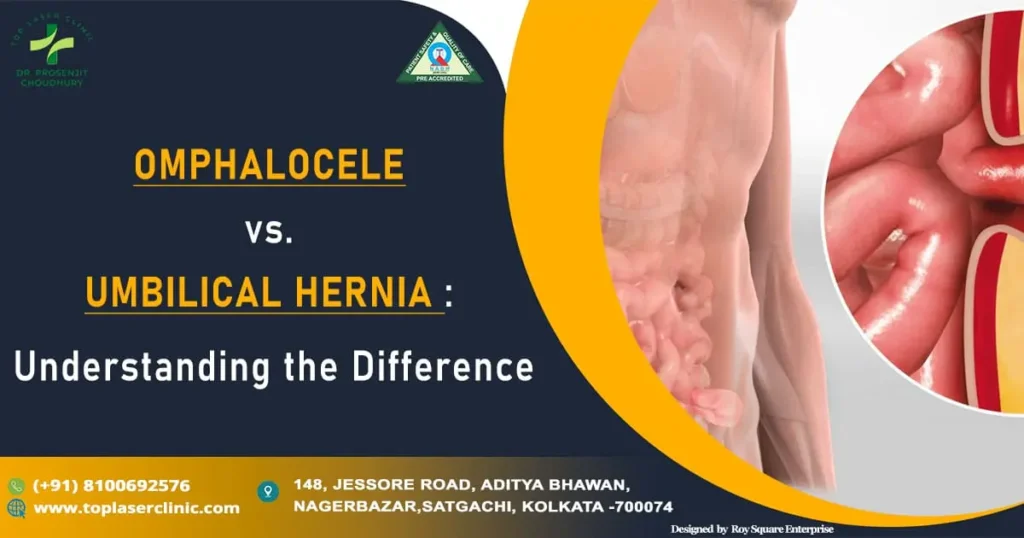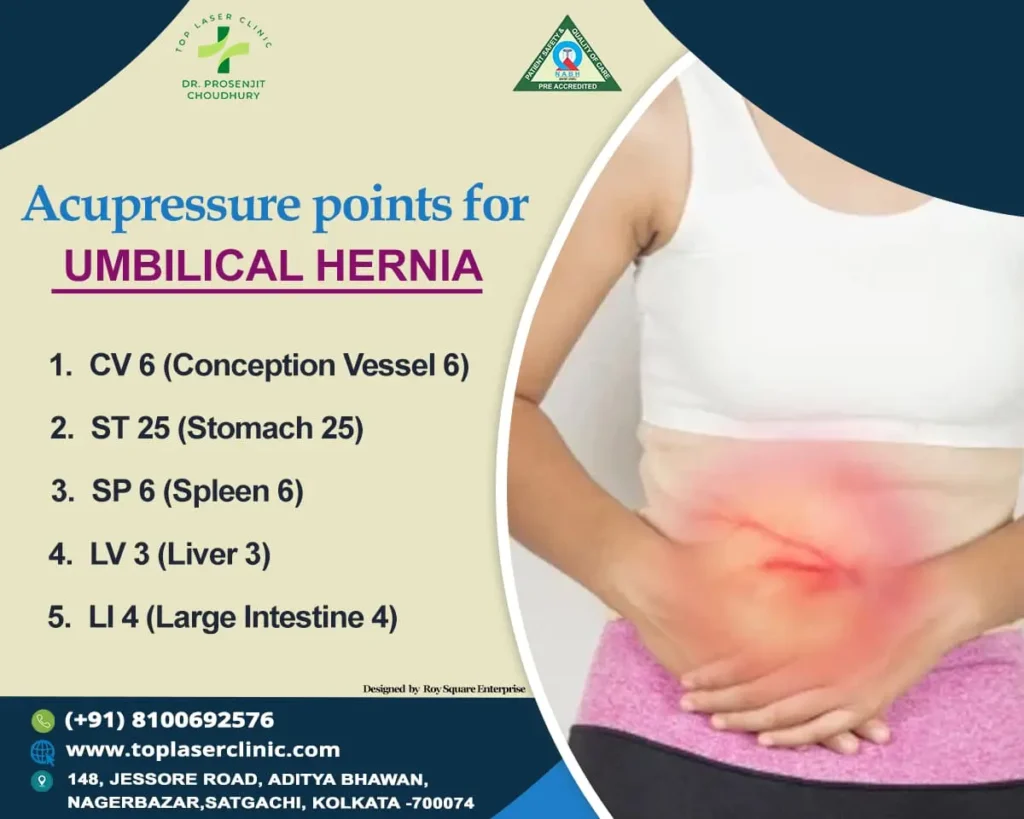Table of Contents
Umbilical Hernia

Umbilical hernia, a condition characterized by the protrusion of abdominal contents through a weakened area near the belly button, is a common medical issue-affecting individual of all ages. Despite its prevalence, many people lack comprehensive knowledge about this condition. In this blog post, we will delve into the causes, symptoms, and treatment options for umbilical hernias, shedding light on this often misunderstood ailment.
Understanding Umbilical Hernia: An umbilical hernia occurs when there’s a weakness in the muscles around the navel, allowing fatty tissue or a portion of the intestine to protrude through the abdominal wall. This bulge near the belly button may be more noticeable when coughing, crying, or straining.
Causes: Several factors can contribute to the development of umbilical hernias, including:
- Congenital Weakness: Babies born prematurely or with a low birth weight are more prone to umbilical hernias due to underdeveloped abdominal muscles.
- Excessive Strain: Persistent pressure on the abdominal wall, such as heavy lifting, obesity, or multiple pregnancies, can weaken the muscles and lead to herniation.
- Genetic Predisposition: Some individuals may have a genetic predisposition to developing hernias, including umbilical hernias.
Symptoms: The most common symptom of an umbilical hernia is a noticeable bulge or swelling near the navel. Other signs and symptoms may include:
- Pain or discomfort at the hernia site, particularly when coughing, bending over, or lifting heavy objects.
- Nausea or vomiting if the hernia becomes incarcerated or strangulated, cutting off blood supply to the protruding tissue.
Diagnosis: Diagnosing an umbilical hernia typically involves a physical examination by a healthcare professional. In some cases, imaging tests such as ultrasound or CT scans may be ordered to confirm the diagnosis and assess the extent of the hernia.
Treatment Options: The management of umbilical hernias depends on various factors, including the size of the hernia, symptoms, and the individual’s overall health. Treatment options may include:
- Watchful Waiting: Small, asymptomatic umbilical hernias in infants often resolve on their own by age 3-4, as the abdominal muscles strengthen.
- Hernia Belt: Wearing a supportive hernia belt or truss may help reduce discomfort and prevent the hernia from enlarging, particularly in individuals who are not candidates for surgery.
- Surgical Repair: For larger or symptomatic hernias, surgical intervention may be necessary to repair the weakened abdominal wall and reduce the risk of complications.
Umbilical hernias are a common yet often misunderstood medical condition that can affect individuals of all ages. By understanding the causes, symptoms, and treatment options for umbilical hernias, individuals can make informed decisions about their healthcare and seek appropriate medical attention when needed. If you suspect you or your child has an umbilical hernia, it’s essential to consult with a healthcare professional for proper evaluation and management.
Remember, this discussion is for informational purposes only and is not substitute of expert medical advice. If you have any concerns about umbilical hernias or any other health-related issues, please consult a qualified healthcare provider.
Omphalocele vs. Umbilical Hernia: Understanding the Difference

When it comes to abdominal wall abnormalities, two conditions often mentioned are omphalocele and umbilical hernia. While both involve the area around the belly button, they are distinct medical conditions with different causes, presentations, and treatment approaches. Let’s delve into the dissimilarities between omphalocele and umbilical hernia:
Omphalocele:
- Definition: Omphalocele is a congenital birth defect characterized by the protrusion of abdominal organs through an opening in the abdominal wall at the base of the umbilical cord. This condition occurs when the muscles fail to close properly during fetal development, resulting in a sac containing abdominal organs such as the intestines, liver, and occasionally other organs, protruding outside the abdomen.
- Causes: The exact cause of omphalocele is not always clear, but it is believed to result from a combination of genetic and environmental factors. Factors such as maternal age, certain medications, and exposure to toxins may increase the risk of omphalocele.
- Presentation: Omphalocele presents as a visible sac at the base of the umbilical cord, containing abdominal organs. The size of the omphalocele can vary, and it may be covered by a membrane or skin. In severe cases, the sac may rupture, leading to complications such as infection or intestinal damage.
- Treatment: Treatment of omphalocele typically involves surgical repair shortly after birth. During the procedure, the protruding organs are gently placed back into the abdomen, and the abdominal wall is closed. In some cases, staged surgeries may be required to address associated abnormalities or complications.
Umbilical Hernia:
- Definition: Umbilical hernia is a common condition characterized by the protrusion of abdominal fat or a portion of the intestine through a weak spot in the abdominal wall near the belly button (umbilicus). Unlike omphalocele, umbilical hernia typically occurs after birth and is not present at birth.
- Causes: Umbilical hernias develop when there is a weakness in the muscles or connective tissue of the abdominal wall, allowing abdominal contents to bulge through. Factors such as obesity, pregnancy, heavy lifting, and persistent coughing can contribute to the development of umbilical hernias in adults.
- Presentation: Umbilical hernias present as a soft bulge or swelling near the belly button. The bulge may be more noticeable when standing, coughing, or straining and may disappear when lying down. Most umbilical hernias are painless and benign, although they may cause discomfort or complications if the hernia becomes incarcerated or strangulated.
- Treatment: Small umbilical hernias that are asymptomatic may not require treatment and may close on their own over time, particularly in infants. However, if the hernia is large, symptomatic, or at risk of complications, surgical repair may be recommended. During the procedure, the weakened area of the abdominal wall is repaired, usually with stitches or a mesh patch, to prevent the hernia from recurring.
In summary, while both omphalocele and umbilical hernia involve abnormalities around the umbilical region, they are distinct conditions with different causes, presentations, and treatment approaches. Omphalocele is a congenital birth defect characterized by the protrusion of abdominal organs through an opening in the abdominal wall, whereas umbilical hernia is a common condition involving the protrusion of abdominal contents through a weak spot in the abdominal wall near the belly button. If you suspect you or your child has either condition, it’s essential to seek medical evaluation and appropriate management from a healthcare professional.
Acupressure points for umbilical hernia

While acupressure may provide some relief for symptoms associated with umbilical hernia, it’s essential to understand that it’s not a substitute for medical treatment. If you suspect you have an umbilical hernia or are experiencing symptoms, it is crucial to consult with a healthcare professional for proper diagnosis and management. However, here are some acupressure points that may offer relief from discomfort associated with umbilical hernia:
- CV 6 (Conception Vessel 6): Located two finger-widths below the belly button, CV 6 is believed to help strengthen the abdominal muscles and alleviate abdominal discomfort. Apply gentle pressure to this point using your fingertips for 1-2 minutes while breathing deeply.
- ST 25 (Stomach 25): Situated two finger-widths lateral to the belly button, ST 25 is thought to aid digestion and relieve abdominal pain. Apply steady pressure to this point with your fingertips for 1-2 minutes.
- SP 6 (Spleen 6): Found on the inner side of the lower leg, about three finger-widths above the ankle bone, SP 6 is believed to promote abdominal circulation and relieve discomfort. Apply gentle pressure to this point using your thumb or index finger for 1-2 minutes.
- LV 3 (Liver 3): Located on the top of the foot, in the depression between the big toe and the second toe, LV 3 is thought to help regulate the flow of qi (energy) in the body and reduce pain. Compress this point with your thumb for a couple of minutes.
- LI 4 (Large Intestine 4): Situated on the back of the hand, in the webbing between the thumb and index finger, LI 4 is believed to relieve abdominal discomfort and promote overall wellness. Apply moderate pressure to this point using your thumb and index finger for 1-2 minutes.
When applying acupressure, it is essential to use gentle but firm pressure and breathe deeply to enhance relaxation. If you experience any discomfort or pain during acupressure, stop immediately. Acupressure should complement, not replace, conventional medical treatment for umbilical hernia. Always consult with a qualified healthcare professional for proper diagnosis and management of your condition.